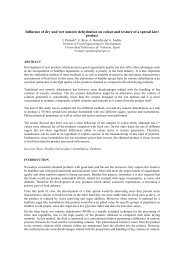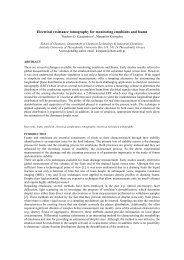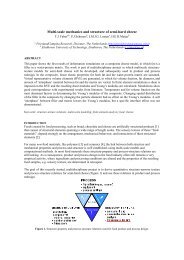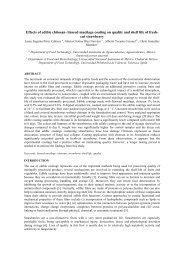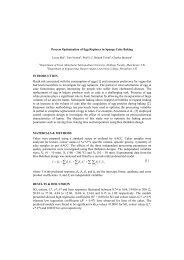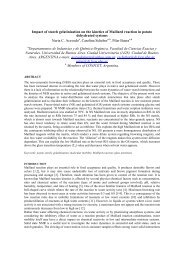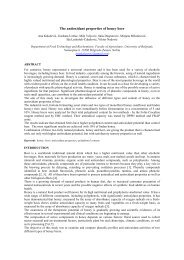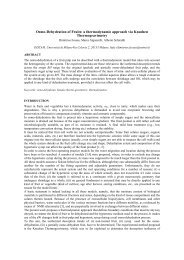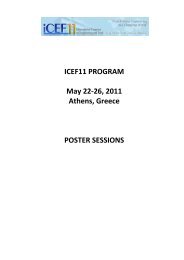Kinetics of Amycolatopsis mediterranei DSM 43304 lipase-mediated ...
Kinetics of Amycolatopsis mediterranei DSM 43304 lipase-mediated ...
Kinetics of Amycolatopsis mediterranei DSM 43304 lipase-mediated ...
Create successful ePaper yourself
Turn your PDF publications into a flip-book with our unique Google optimized e-Paper software.
MATERIALS & METHODS<br />
Biocatalyst<br />
A. <strong>mediterranei</strong> <strong>DSM</strong> <strong>43304</strong> having high lipolytic activity was screened and optimized for <strong>lipase</strong> production<br />
as described by Dheeman et al. [13]. The extracellular <strong>lipase</strong> from A. <strong>mediterranei</strong> <strong>DSM</strong> <strong>43304</strong> was<br />
immobilized onto Celite matrix and the hydrolytic activity <strong>of</strong> the Celite-immobilized <strong>lipase</strong> was measured<br />
titrimetrically using an olive oil emulsion in 50 mM Tris-HCl buffer (pH 8) at 37 °C [14]. With this assay,<br />
the activity <strong>of</strong> Celite-immobilized <strong>lipase</strong> was 120 IU g -1 . The water content <strong>of</strong> the immobilized enzyme<br />
particles, by comparison <strong>of</strong> weight before and after heating at 105 °C for 12 h, was determined to be 2.2%<br />
(w/w). The same initial batch <strong>of</strong> immobilized <strong>lipase</strong> was used throughout the realization <strong>of</strong> this work.<br />
Esterification reaction<br />
Unless stated otherwise, synthesis <strong>of</strong> isoamyl acetate was carried out in a mechanically agitated glass reactor<br />
with 50 mL capacity. The reactor containing 300 mM <strong>of</strong> isoamyl alcohol and 750 mg Celite-immobilized A.<br />
<strong>mediterranei</strong> <strong>DSM</strong> <strong>43304</strong> <strong>lipase</strong> as a catalyst in n-hexane was placed in a thermostatic water bath providing a<br />
constant temperature to within ±0.1 °C. When the reaction temperature reached the set value (37 °C), acetic<br />
acid was added, to a final concentration <strong>of</strong> 300 mM, to initiate the reaction (total reaction volume 10 mL). A<br />
reaction in the same conditions without enzyme was realized in parallel and was used as a control. All<br />
experiments were performed in duplicate and replicated at least twice. The samples were analyzed on a gas<br />
chromatograph (Perkin Elmer AutoSystem XL, MA, USA) connected to a DB-5 capillary column (30 m ×<br />
0.25 mm, d f 0.25 µm, Agilent JW Scientific, CA, USA) and a flame ionization detector (FID).<br />
Kinetic modeling<br />
For kinetic modeling a total <strong>of</strong> 20 batch experiments were performed providing a total <strong>of</strong> 180 duplicate data<br />
points. Initial reaction rates were obtained from the experimental concentration-time pr<strong>of</strong>iles by regression <strong>of</strong><br />
the linear portion <strong>of</strong> the kinetic data. The experimental concentration pr<strong>of</strong>iles were fitted to the kinetic<br />
models using the Levenberg-Marquardt nonlinear regression algorithm available in the ODRPACK [15]. The<br />
differential equations resulting from the different ester synthesis mechanism simplifications used in the<br />
nonlinear regression was simulated using the ODEPACK library [16].<br />
RESULTS & DISCUSSION<br />
Effect <strong>of</strong> reaction parameters<br />
The effect <strong>of</strong> varying the enzyme loading on the rate <strong>of</strong> reaction was investigated by gradually increasing the<br />
mass <strong>of</strong> enzyme from 0.25 to 1.50 g <strong>of</strong> enzyme (i.e., from 0.83 to 5.0 g <strong>of</strong> enzyme mol -1 <strong>of</strong> the limiting<br />
substrate) at a constant agitation <strong>of</strong> 120 rpm. The results showed that the reaction rate increased linearly with<br />
increased enzyme loading. For the enzymatic synthesis <strong>of</strong> other esters, similar behaviour was found in the<br />
literature [5, 17]. The curves overlapped for larger enzyme loadings (≥5.0 g mol -1 ), suggesting there was no<br />
free substrate to bind with the excess <strong>of</strong> enzyme or external mass transfer resistance was limiting the rate.<br />
Such a rate limitation was also reported for the enzymatic synthesis <strong>of</strong> ethyl palmitate, isoamyl acetate, and<br />
octyl acetate [5, 18, 19]. Since there was no significant increase in rate and conversion with increased<br />
enzyme loadings (>2.5 g mol -1 ), further experiments were performed using enzyme loadings <strong>of</strong> 2.5 g mol -1<br />
(7.5%, w/v).<br />
In the present study, preliminary experiments were performed to ensure the absence <strong>of</strong> external and internal<br />
diffusion limitations in all experiments. The effect <strong>of</strong> speed <strong>of</strong> agitation on initial rate and conversion was<br />
studied over the range <strong>of</strong> 80 to 250 rpm. It was found that both the initial rate and conversion increased with<br />
agitation speeds from 80 to 200 rpm with no significant increase above 200 rpm, indicating the reaction rate<br />
and conversion were no longer limited by mass transfer limitations <strong>of</strong> immobilized enzyme at 200 rpm.<br />
However, above 200 rpm, there was no significant increase in reaction rate and conversion.<br />
In order to assess the influence <strong>of</strong> initial concentration <strong>of</strong> substrates on the reaction kinetics, with the aim<br />
<strong>of</strong>optimizing initial rate and conversion, experiments with different substrate molar ratios were examined.<br />
The enzyme loading (2.5 g mol -1 ) and the concentration <strong>of</strong> isoamyl alcohol were kept constant in this set <strong>of</strong><br />
experiments. The initial rate <strong>of</strong> reaction and equilibrium conversion increased with increasing acetic acid<br />
concentration up to a critical value (600 mM); however, further increase <strong>of</strong> acetic acid concentration above<br />
600 mM, i.e, for an acetic acid/isoamyl alcohol molar ratio >2, resulted in decreased initial rate and<br />
equilibrium conversion. The decreased initial rates and conversion may be due to the formation <strong>of</strong> ineffective<br />
enzyme-substrate complexes at high substrate concentrations [12, 17]. Moreover, polar substrates tend to<br />
accumulate in the micro-queous environment <strong>of</strong> the suspended enzyme and may reach concentration levels



